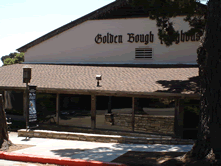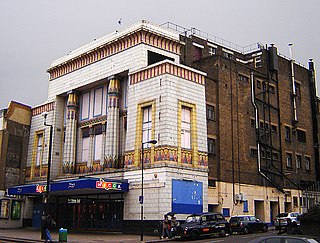Related Research Articles

Stoke-upon-Trent, commonly called Stoke is one of the six towns that along with Hanley, Burslem, Fenton, Longton and Tunstall form the city of Stoke-on-Trent, in Staffordshire, England.

Stoke-on-Trent is a city and unitary authority area in Staffordshire, England, with an area of 36 square miles (93 km2). In 2019, the city had an estimated population of 256,375. It is the largest settlement in Staffordshire and is surrounded by the towns of Newcastle-under-Lyme, Alsager, Kidsgrove, Biddulph and Stone which form a conurbation around the city.

Longton is one of the six towns which amalgamated to form the county borough of Stoke-on-Trent in 1910, along with Hanley, Tunstall, Fenton, Burslem and Stoke-upon-Trent.
The New Vic Theatre in Newcastle-under-Lyme, Staffordshire, England, is a purpose-built theatre in the round which opened in 1986, replacing a converted cinema, the Victoria Theatre, Hartshill, Stoke-on-Trent.

Longton railway station is a railway station in England at Longton, Stoke-on-Trent. The station is served by trains on the Crewe to Derby Line which is also a community rail line known as the North Staffordshire line. The station is owned by Network Rail and managed by East Midlands Railway. The full range of tickets for travel are purchased from the guard on the train at no extra cost.

The Regent Theatre is a theatre in Stoke-on-Trent, England. Constructed in 1929 as a cinema, it is one of several theatres in the city centre and one of two operated by the Ambassador Theatre Group on behalf of Stoke-on-Trent City Council. The building was converted for full-time use as a theatre in 1999, and since then has hosted a number of shows and musicals. The theatre is also the northern base for the Glyndebourne Touring Opera.

The Gladstone Pottery Museum is a working museum of a medium-sized coal-fired pottery, typical of those once common in the North Staffordshire area of England from the time of the industrial revolution in the 18th century to the mid 20th century. It is a grade II* listed building.

The Golden Bough Playhouse is a historic two-story theatre in Carmel-by-the-Sea, California on Monte Verde St., between 8th and 9th Avenues. The playhouse occupies the site of the former Carmel Arts and Crafts Club, Carmel's first cultural center and theatre, built in 1906–1907 on Casanova Street, and the Arts and Crafts Hall, built in 1923–1924 on an adjacent lot on Monte Verde Street. The theatre was recorded with the National Register of Historic Places on July 3, 2002. It is significant as a California historic building because it is located on the original site of the Carmel Arts and Crafts Club and theatre, the oldest performing arts venues in Carmel.
Shelley's Laserdome was a night club in Longton, Stoke-on-Trent, Staffordshire, England. It was at the heart of the house and rave scene in the early 1990s, helping to launch the career of DJ Sasha and featuring regular appearances from Carl Cox. It was eventually shut down by Staffordshire Police.
Longton Cricket Club Ground is a cricket ground in Stoke-on-Trent, Staffordshire. The first recorded match on the ground was in 1954, when Staffordshire played Northumberland in the grounds first Minor Counties Championship match. From 1954 to present, the ground has hosted 40 Minor Counties Championship matches and 7 MCCA Knockout Trophy matches.
The Alhambra Theatre in Higher Openshaw, Manchester, England, was opened in 1910, part of the H. D. Moorhouse Theatre Circuit, but it had been converted to a cinema by the outbreak of the First World War in 1914. The cinema was converted into a bingo hall in the early 1960s. The auditorium was finally used as a sporting club, and what remained of the building was used as a restaurant, storage space and glass works. The Alhambra was demolished in 2009 to make way for a new Morrisons supermarket.

In 1898 William Morton's Theatre Royal showed a 'Veriscope' film, probably the first time any film was shown in a Hull theatre. The Prince's Hall was the first purpose-built cinema in Kingston upon Hull, and was opened in George Street by Morton in 1910. As Hull embraced the new age of public entertainment, attendances at traditional theatre declined. Luxurious cinemas, taking their inspiration from theatres and music halls, were built to accommodate audiences in almost every neighbourhood in the city. By 1914, there were 29 cinemas, theatres and halls showing films in the city. The London and Provincial Cinema Company owned the Hippodrome; the National Electric Picture Theatres owned the Theatre de Luxe, but Morton's was the largest and most influential cinema chain in Hull.

John Stanley Coombe Beard FRIBA, known professionally as J. Stanley Beard, was an English architect known for designing many cinemas in and around London.

The New Theatre Royal is a Victorian Grade II* listed theatre in the heart of Portsmouth, England, with a capacity of 667. The theatre building was constructed in 1854 as Landport Hall. It was converted to a theatre two years later. It was rebuilt in 1884 by Charles J. Phipps and again in 1900 by Frank Matcham.

The Kettering Savoy was a theatre and cinema in Russell Street, Kettering, Northamptonshire, England.
The Theatre Royal, Hanley was a theatre in Stoke-on-Trent, England with a long history.
Jollees was a live music and cabaret venue in Longton, Stoke-on-Trent, United Kingdom. The venue was re-established in March 2016, after having closed in 1992. The original venue was opened in October 1973 and was the largest capacity cabaret venue in the UK in the 1970s. It also hosted the World Professional Darts Championship from 1979 to 1985.

The former Carlton Cinema is an Art deco Grade II* listed building, located at 161–169 Essex Road, Islington, London. It was completed in 1930 as a cine-variety theatre with a capacity of 2,226 seats.

Stoke-on-Trent Repertory Theatre is a theatre in Stoke-on-Trent, England. It opened in 1997.
The Gordon Theatre was a theatre in Stoke-upon-Trent, in Staffordshire, England. It was subsequently the Hippodrome Theatre, and the Gaumont Cinema.
References
- 1 2 3 4 5 "Theatres and Halls in Stoke on Trent, Staffordshire" arthurlloyd.co.uk. Retrieved 9 January 2021.
- 1 2 3 4 "Empire Theatre" Theatres Trust. Retrieved 9 January 2021.
- ↑ Neale, William (2011) [2010]. Old Theatres in the Potteries (2nd ed.). William A. Neale. pp. 143–160. ISBN 9781446638460.
- 1 2 3 "Empire Theatre" Cinema Treasures. Retrieved 9 January 2021.
- ↑ "Repertory" Theatres Trust. Retrieved 9 January 2021.